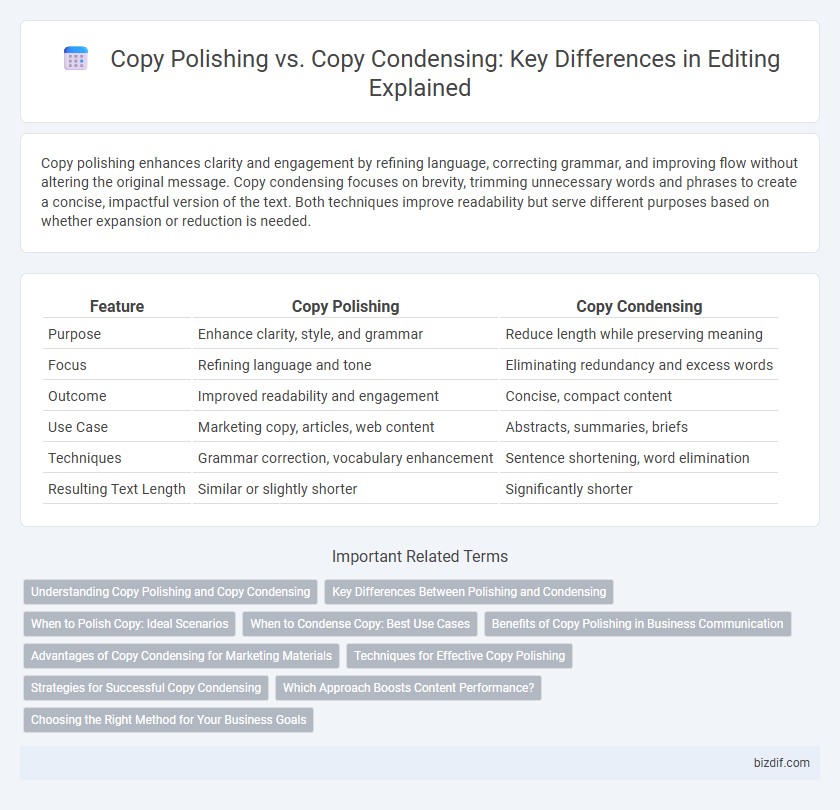Copy polishing enhances clarity and engagement by refining language, correcting grammar, and improving flow without altering the original message. Copy condensing focuses on brevity, trimming unnecessary words and phrases to create a concise, impactful version of the text. Both techniques improve readability but serve different purposes based on whether expansion or reduction is needed.
Table of Comparison
| Feature | Copy Polishing | Copy Condensing |
|---|---|---|
| Purpose | Enhance clarity, style, and grammar | Reduce length while preserving meaning |
| Focus | Refining language and tone | Eliminating redundancy and excess words |
| Outcome | Improved readability and engagement | Concise, compact content |
| Use Case | Marketing copy, articles, web content | Abstracts, summaries, briefs |
| Techniques | Grammar correction, vocabulary enhancement | Sentence shortening, word elimination |
| Resulting Text Length | Similar or slightly shorter | Significantly shorter |
Understanding Copy Polishing and Copy Condensing
Copy polishing involves refining text to enhance clarity, flow, and style without removing essential content, ensuring the message remains engaging and precise. Copy condensing focuses on reducing wordiness by eliminating redundancy and unnecessary details to create a more concise and impactful version. Understanding these distinct editing techniques helps tailor content to specific communication goals, whether emphasizing depth or brevity.
Key Differences Between Polishing and Condensing
Copy polishing enhances clarity, flow, and style while maintaining the original length and content, focusing on grammar, punctuation, and word choice improvements. Copy condensing reduces word count by eliminating redundancy and unnecessary details to make the text more concise and impactful. Polishing preserves the writer's voice and intent, whereas condensing prioritizes brevity and efficiency in communication.
When to Polish Copy: Ideal Scenarios
Copy polishing is ideal when content needs enhanced clarity, tone refinement, and stylistic consistency to engage target audiences effectively. It suits marketing materials, website content, and professional reports where nuanced language and persuasive messaging are critical. Polishing also benefits documents requiring adherence to brand voice and error-free presentation without reducing length.
When to Condense Copy: Best Use Cases
Condense copy when targeting audiences with limited attention spans, such as social media users or email subscribers, to deliver concise and impactful messages quickly. Use copy condensing to simplify complex information, making it more accessible for instructional materials or executive summaries. Prioritize condensing in marketing content where brevity drives engagement and conversion rates.
Benefits of Copy Polishing in Business Communication
Copy Polishing enhances clarity, professionalism, and engagement in business communication by refining tone, grammar, and style to ensure the message resonates with the target audience. It improves brand perception and reduces misunderstandings, fostering stronger client and stakeholder relationships. This leads to increased trust and higher conversion rates, ultimately supporting business growth and reputation.
Advantages of Copy Condensing for Marketing Materials
Copy condensing enhances marketing materials by delivering concise, impactful messages that capture audience attention quickly and improve readability across diverse platforms. This streamlined approach reduces information overload, making key benefits and calls-to-action stand out, which boosts engagement and conversion rates. Shorter, focused copy also supports consistent brand messaging and better adapts to digital formats like social media, email campaigns, and mobile advertising.
Techniques for Effective Copy Polishing
Techniques for effective copy polishing involve enhancing clarity, consistency, and tone by refining sentence structure, eliminating redundancy, and ensuring precise word choice. Emphasizing active voice and varied sentence lengths improves readability and engagement. Focused proofreading for grammar, punctuation, and style adherence solidifies a polished, professional final draft.
Strategies for Successful Copy Condensing
Successful copy condensing relies on strategies like prioritizing core messages, eliminating redundancies, and using concise language to maintain clarity and impact. Effective condensing involves restructuring sentences to combine ideas while preserving essential meaning and tone. Utilizing tools such as readability analyzers and iterative editing ensures the text remains engaging and informative despite reduced length.
Which Approach Boosts Content Performance?
Copy polishing enhances content by refining language, improving clarity, and ensuring grammatical accuracy, which increases reader engagement and credibility. Copy condensing streamlines text by eliminating redundancy and focusing on key messages, improving readability and user retention. Choosing between these approaches depends on content goals: polishing suits detailed storytelling, while condensing benefits concise messaging for higher content performance.
Choosing the Right Method for Your Business Goals
Copy polishing enhances clarity, tone, and flow to better engage your target audience and reflect your brand's voice. Copy condensing streamlines content by removing redundancy and focusing on key messages, ideal for businesses needing concise communication. Selecting between polishing and condensing depends on whether your priority is improving reader experience or delivering brief, impactful information aligned with your marketing objectives.
Copy Polishing vs Copy Condensing Infographic

 bizdif.com
bizdif.com